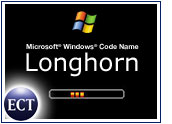
Microsoft’s long-anticipated operating system — code-named Longhorn — has been hard to lasso. The company has been carefully controlling disclosures about the new OS, which is slated to be released in 2005. Even developers are keeping mum, for the most part.
Extreme Logic’s Paul Hernacki, like other software developers, spoke cautiously about Longhorn. Hernacki told TechNewsWorld that most of what he knows about Longhorn cannot be disclosed because of the air-tight nondisclosure agreement his company signed with Microsoft.
But that has not stopped some people from leaking pieces of the software to the Internet. Those leakages, plus remarks by Microsoft executives in carefully calculated speeches and off-the-record remarks by developers, are providing consumers with a glimpse of the future of personal computing.
Not Just Windows
“Longhorn is not just a release of a Windows client,” Microsoft founder Bill Gates said in a meeting with financial analysts last month. Instead, it is a “big bet” that will be accompanied by “advances in office and server” products.
During the recent Windows Hardware Engineering conference, Will Poole, senior vice president of Microsoft’s Windows client division, said the company will release a “couple of beta versions” of the software later this year. But he noted that the software will not be commercially available for two more years.
According to developers, the operating system relies heavily on Extensible Markup Language (XML) to display the desktop manager and other system elements, such as the clock. Leaked versions of the operating system have been identified as Windows 6.0 — a major upgrade in lineage from the Windows XP 5.1 version designator.
Unified Application
The new operating system will feature an improved file storage system designed to make it easier to find information on a PC’s hard drive. This file system — called Windows Future Storage (WinFS) — will provide users with a new means of indexing, storing and accessing files and will replace the storage systems used in earlier versions of Windows.
These older systems were called the File Allocation Table, or FAT, and the Windows NT File System (NFTS). One source said the new storage system will let computer users locate files by their content — whether they are word processing files or spreadsheets or even e-mail. This technology likely will end up replacing the aftermarket products that can perform this task as add-ons to Windows.
Microsoft also is working on ways to let users work with all files through a single program, rather than having to open a word-processing application or a spreadsheet application separately.
Better Graphics
At the conference, Microsoft also disclosed that Longhorn’s graphical user interface will have a much higher resolution than its current Windows XP operating system — 120 dots per inch or more. Presently, most displays have a resolution of 95 dots per square inch. With more dots, users will perceive a crisper, more defined display, making high-resolution images look much better on screens.
Other graphics improvements are part of the plan as well. A new applet will allow users to shrink the size of their application interfaces, as seen on the screen, without distorting their resolution. Another feature is likely to be a new media transport protocol, making it easier to swap files with friends and colleagues. In addition, Microsoft’s new audio architecture will make it easier to connect the operating system to audio devices, such as a stereo.
The operating system also is said to be compatible with set-top box software, which will let homeowners network their TV and their PCs seamlessly.
Fixes Forthcoming
The system also features new security software linked to a computer’s hardware, which neither Linux nor Unix has presently.
“This is a huge bet for the company,” said Poole during the conference. “It will really change the landscape of what people see.”
But some are not so impressed with Microsoft’s effort because it will be almost two years from now until the final version is released commercially. Many of the problems that the operating system seeks to solve plague users today.
“With typical e-mail clients and file managers, programs and documents are stored in one way, contacts and e-mails in another, and they aren’t integrated so that they are easily searchable,” Vladimir Spirine, president of software developer EverEZ Systems, told TechNewsWorld.
Work Ahead
But Microsoft says there is still a lot of work to be done on Longhorn.
“The road between now and Longhorn is not super short,” said Poole. “We’ve got some work to do. It’s going to take us a while to get there. And what you’ll see is there are a couple of major milestones, a couple big road signs there.”
In the meantime, the industry expects interim releases from Microsoft.
“Currently, we have some additional releases that are coming out as follow-ons to the XP Media Center Edition and the Tablet PC Edition … new handwriting recognition, new guide data for Europe for the Media Center, and so on,” said Poole.
“So you’ll see some good incremental moves there, but really the weight of the company, the weight of all the people in the Windows client division and across the platform’s division, the weight of that effort that we’re [making] is around Longhorn.”



















































